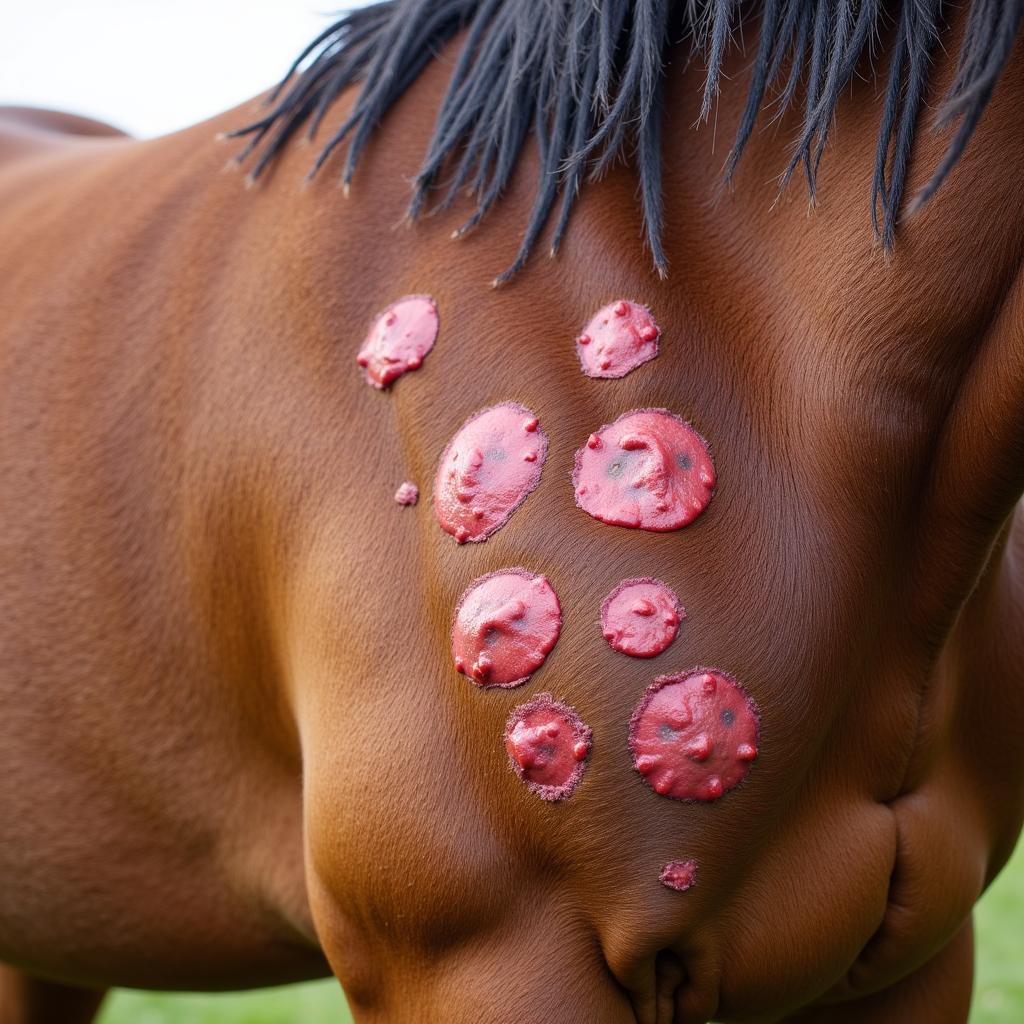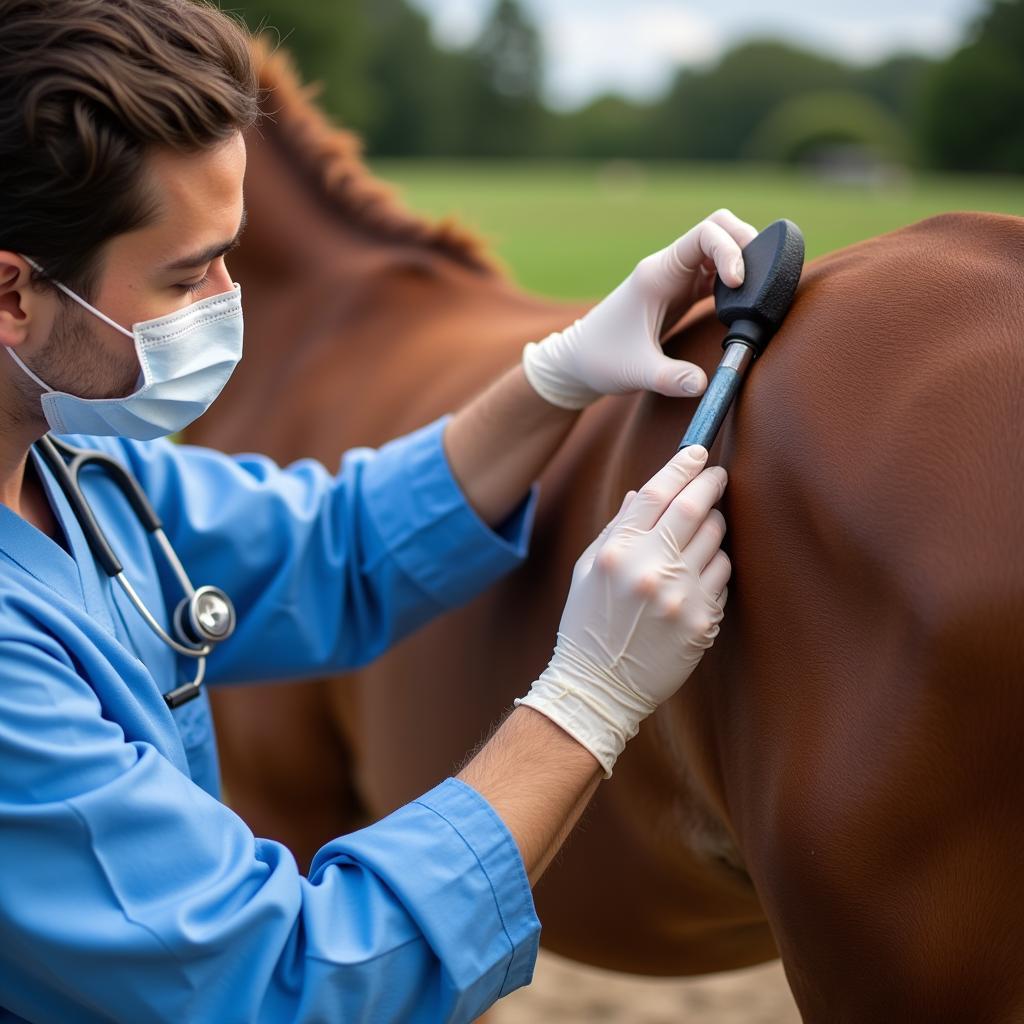Allergic Reaction Protein Bumps On Horses can be a frustrating and sometimes concerning issue for horse owners. Understanding the causes, symptoms, and treatment options is crucial for effectively managing these reactions and ensuring your horse’s comfort. This comprehensive guide will delve into the various aspects of allergic reactions in horses, focusing on protein bumps, to equip you with the knowledge you need to provide the best possible care for your equine companion.
Understanding Equine Allergic Reactions
Horses, just like humans, can experience a range of allergic reactions. These reactions occur when the horse’s immune system overreacts to a normally harmless substance, known as an allergen. These allergens can be inhaled, ingested, or come into direct contact with the skin. Protein bumps, specifically, are often a sign of a hypersensitivity reaction, where the body’s immune response is exaggerated and leads to inflammation and the formation of raised welts or bumps on the skin.
Common Allergens for Horses
Several common allergens can trigger allergic reactions and protein bumps in horses:
- Insect Bites: Bites from flies, mosquitoes, midges, and other insects are a frequent cause of allergic skin reactions.
- Feeds: Certain proteins in feed, such as alfalfa or soybean meal, can trigger allergic responses in sensitive horses.
- Pollens: Airborne pollen from trees, grasses, and weeds can cause respiratory allergies and, in some cases, skin reactions.
- Molds and Dust: Exposure to mold spores and dust, particularly in hay or bedding, can lead to allergic reactions.
- Medications: While less common, some horses can develop allergies to certain medications, resulting in skin manifestations like hives or bumps.
 Horse Showing Allergic Reaction to Insect Bites
Horse Showing Allergic Reaction to Insect Bites
Identifying Allergic Reaction Protein Bumps
Recognizing the signs of an allergic reaction in your horse is crucial for timely intervention. Protein bumps associated with allergic reactions typically present as:
- Raised Welts or Hives: These bumps can vary in size and may be localized or widespread across the body.
- Itching and Irritation: The affected areas are often itchy, leading to rubbing and potential secondary skin infections.
- Hair Loss: In some cases, hair loss may occur in the areas where the bumps are present.
- Respiratory Symptoms: If the allergen is inhaled, the horse may also exhibit respiratory symptoms such as coughing, wheezing, or nasal discharge.
What Do Allergic Reaction Protein Bumps Look Like?
Allergic reaction protein bumps on horses often resemble hives in humans. They can be small, round, and raised, or they may appear as larger, more irregularly shaped welts. The color can vary from pink to red, and the skin around the bumps may be inflamed.
 Horse Skin Showing Allergic Reaction with Protein Bumps
Horse Skin Showing Allergic Reaction with Protein Bumps
Treating Allergic Reactions in Horses
Once you suspect your horse is experiencing an allergic reaction, it’s essential to consult with a veterinarian. They can accurately diagnose the cause of the reaction and recommend the most appropriate treatment plan.
Veterinary Diagnosis and Treatment Options
Veterinarians may utilize several methods to diagnose allergies, including skin testing and blood tests. Treatment options may include:
- Antihistamines: These medications can help reduce itching and inflammation associated with allergic reactions.
- Corticosteroids: In more severe cases, corticosteroids may be prescribed to suppress the immune response and control inflammation.
- Avoiding the Allergen: Identifying and eliminating the allergen is the most effective long-term solution. This might involve changing feeds, using different bedding, or implementing insect control measures.
- Hyposensitization: In some cases, hyposensitization therapy (allergy shots) can be used to gradually desensitize the horse to the allergen.
“Identifying the specific allergen is key to effective management. Environmental control and avoidance are often the first line of defense,” says Dr. Emily Carter, DVM, specializing in equine dermatology.
 Veterinarian Examining Horse Skin for Allergy
Veterinarian Examining Horse Skin for Allergy
Preventing Allergic Reactions
While not all allergic reactions can be prevented, certain management practices can help reduce the risk:
- Good Hygiene: Maintaining a clean and dry environment can minimize exposure to allergens like mold and dust.
- Insect Control: Implementing effective insect control measures, such as fly sprays and masks, can help prevent insect bite allergies.
- Careful Feed Selection: Choose high-quality feeds and avoid sudden changes in diet. Introduce new feeds gradually to monitor for any adverse reactions.
- Regular Grooming: Regular grooming helps remove potential allergens from the horse’s coat and skin.
Conclusion
Allergic reaction protein bumps on horses can be effectively managed with proper diagnosis and treatment. By understanding the causes, symptoms, and preventative measures, you can play a vital role in ensuring your horse’s health and well-being. Remember to consult with your veterinarian for personalized guidance and support.
FAQ
- What are the most common signs of an allergic reaction in horses?
- How can I tell if the bumps on my horse are due to an allergy?
- What are the treatment options for allergic reactions in horses?
- How can I prevent my horse from developing allergies?
- Can allergies be cured in horses?
- What should I do if I suspect my horse is having an allergic reaction?
- Are certain breeds of horses more prone to allergies?
Need support? Contact us 24/7: Phone: 0772127271, Email: [email protected] Or visit us at: QGM2+WX2, Vị Trung, Vị Thuỷ, Hậu Giang, Vietnam.